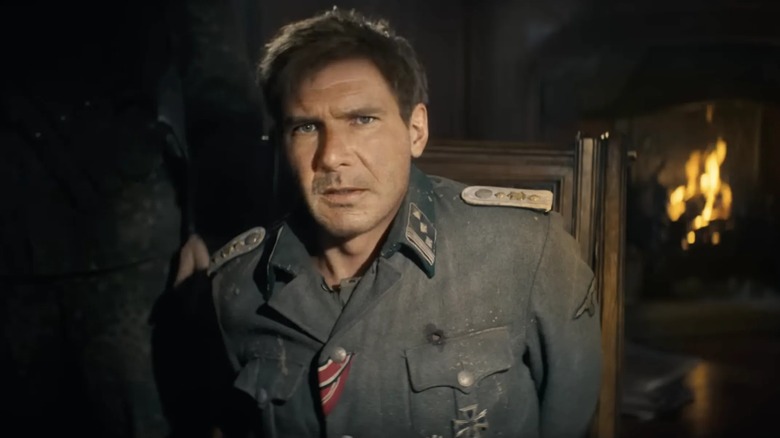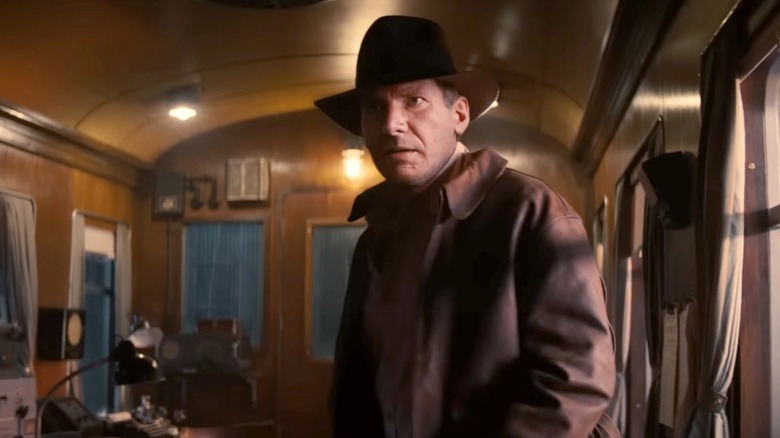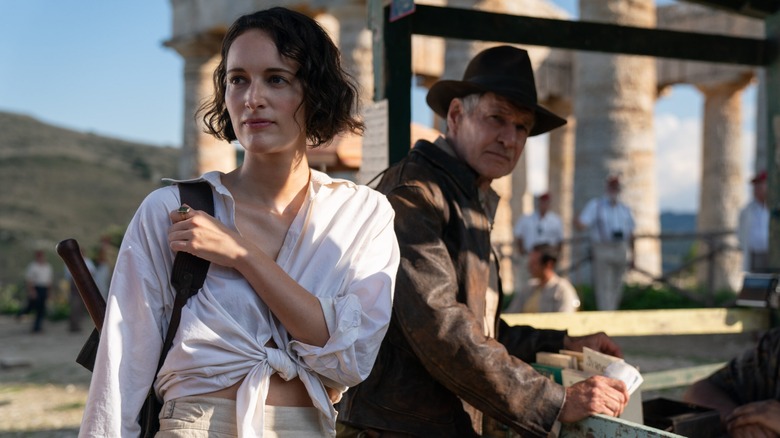Why Indiana Jones And The Dial Of Destiny Is Utilizing Young Indy Flashbacks
It started out as one of the best kept secrets of 2016's "Rogue One: A Star Wars Story" — halfway through the film, Lucasfilm and Industrial Light and Magic posthumously revitalized the late Peter Cushing by digitally reconstructing his performance as Admiral Grand Moff Tarkin in full CGI. In the same movie, a young, uncanny version of Carrie Fisher's Princess Leia receives the Death Star plans from her rebel allies, ending the film on her hopeful image.
Despite negative feedback and a fair share of moral concerns from critics over their AI de-aging tech, it appears Lucasfilm have only become dead set on perfecting it. A de-aged Luke Skywalker has even become a recurring character on "The Mandalorian" and "The Book of Boba Fett." Now, in all the latest trailers for Indy's comeback adventure, "Indiana Jones and the Dial of Destiny," it seems like it's 80-year-old Harrison Ford's turn in the ILM time machine. We've been shown impressive glimpses of a de-aged Ford, looking straight out of "Raiders of the Lost Ark."
The technology only seems to be improving, but does it have any true storytelling value? James Mangold, the director of "Dial of Destiny," seems to think so. Mangold explained to The Hollywood Reporter his motivation for including flashback sequences that utilize Lucasfilm's de-aging AI technology. The director reassured that his use of the technology isn't just for cheap nostalgia or a "fun throwback," but instead will provide context for Indy's character journey throughout the film.
"It reminds the audience of the contrast between a hero in his physical prime and a hero at 70," Mangold said. "We're not relying solely on the audience's memory of the previous films. It reminds everyone what he's done, what he's survived, what he's accomplished."
Confronting the past to find closure in the present
Outside of the opening flashbacks, we know that "Dial of Destiny" is mostly set in 1969. The ghosts of the post-WWII era continue to haunt this politically fractious time. In particular, Mangold channeled Operation Paperclip, in which the United States recruited Nazi scientists post-WWII to work for our government in exchange for protection from their war charges. As his enemies become integrated into American society, Indy will encounter a crisis of morality. As Mangold put it:
"Who's a villain? Who are we working with? Who are we fighting against? Proxy wars, all of that. It's not as simple as the era around World War II. What happens to a hero built for a black-and-white world, when he finds himself in one that is gray? It's a problem that produces humor, produces contradictions, produces adjustments that this character's going to have to make."
As the director of "Logan," Mangold knows a thing or two about men finding closure in a changing era. The director explained that in order to explore the reality of Indy's present, they had to confront his past. "By showing him [at] his most hearty and then finding him at 70 in New York City, it produces for the audience a kind of wonderful whiplash of how they're going to have to readjust and retool their brains for this guy," Mangold said. "His past is a live memory for the audience, hanging over a man who is now living with anonymity in a world that no longer cares or recognizes the things he felt so deeply about."
'You're left with a multilayered perception of his character'
Recently, Ford revealed that he specifically requested the jokes about Indy's old age to be left out of the script of "Dial of Destiny." We're on his side on that one — there's no need to keep reiterating the obvious — but Mangold's main ambition for his Indy film is sending the character off well. From his perspective, there's no proper way to do that without acknowledging the life he led before the events of this film. Relegating the young Indy sequence to the opening of the film, he hopes that the audience feels the contrast between past and present.
Mangold shared with THR, "You're left with a multilayered perception of his character, both what he was and what he is, and how the world is different between the first 20 minutes of the movie." At least to James Mangold, the AI de-aging tech Lucasfilm has been specializing does have authentic storytelling potential. However, heavily featuring it in a franchise that was so previously defined by Steven Spielberg's sharp, classical filmmaking and George Lucas' (both executive producers on "Dial of Destiny") deep imagination, it might be a tougher sell to some purists.
Either way, we'll go in with an open mind when "Indiana Jones and the Dial of Destiny" hits theaters on June 30, 2023.


